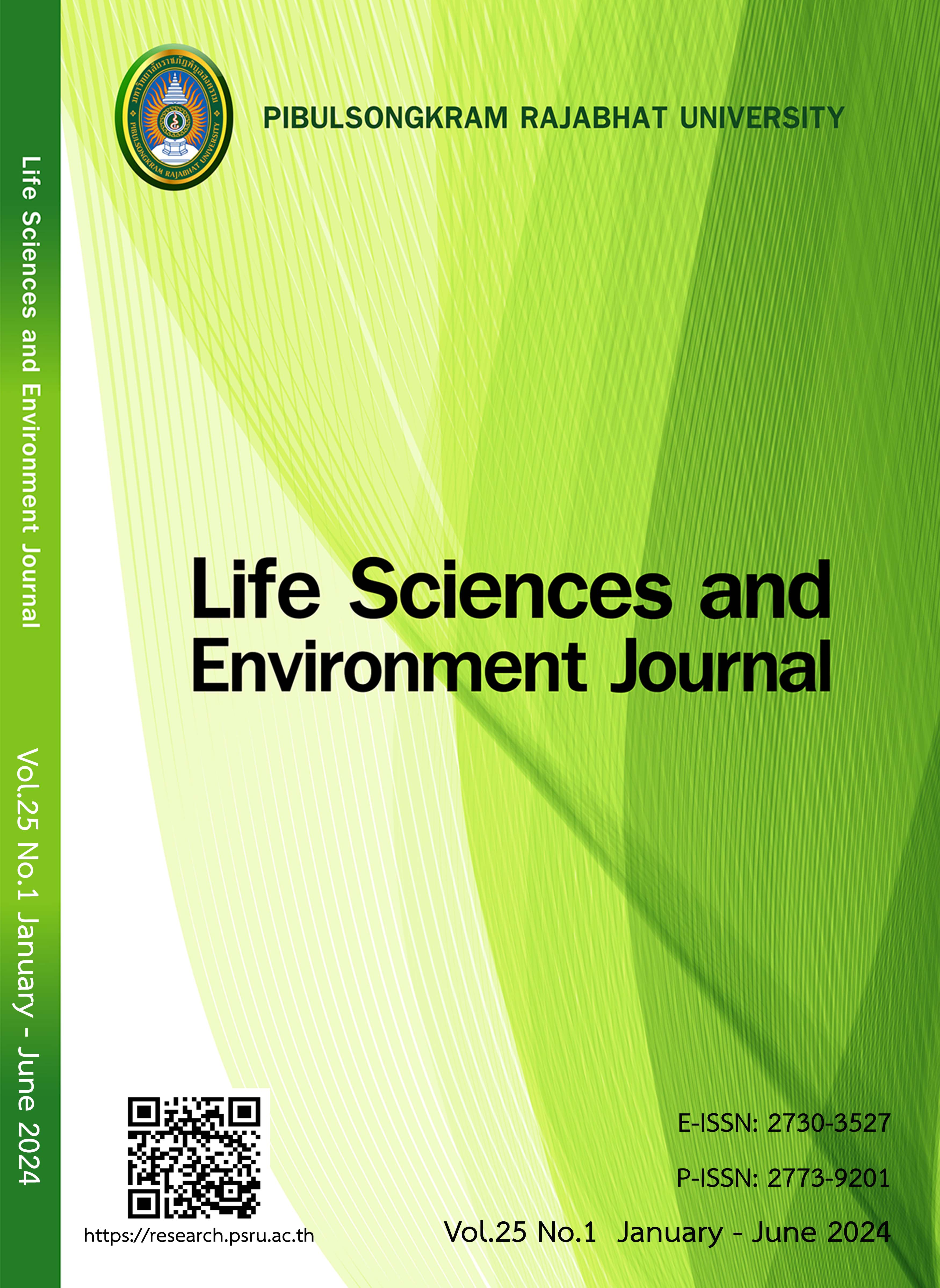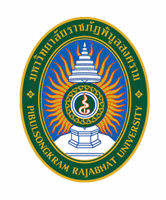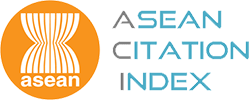ผลของอัตราส่วนกากตะกอนน้ำเสียและเส้นใยปาล์มที่มีต่อคุณภาพปุ๋ยหมัก
DOI:
https://doi.org/10.14456/lsej.2024.8คำสำคัญ:
ปุ๋ยหมัก, กากตะกอนน้ำเสีย , เส้นใยปาล์มบทคัดย่อ
กากตะกอนน้ำเสียจัดเป็นของเสียจากอุตสาหกรรมที่มีปริมาณธาตุอาหารและสารอินทรีย์สูง การวิจัยครั้งนี้เป็นการศึกษาอัตราส่วนการผลิตปุ๋ยหมักโดยใช้กากตะกอนน้ำเสียต่อเส้นใยปาล์ม 6 อัตราส่วน ได้แก่ 100:0, 90:10, 80:20, 70:30, 60:40 และ 50:50 ระยะเวลาหมัก 60 วัน ผลการวิจัย พบว่า ปุ๋ยหมักทุกอัตราส่วนมีสมบัติทางกายภาพเป็นไปตามเกณฑ์มาตรฐานปุ๋ยอินทรีย์ของกรมวิชาการเกษตร ส่วนสมบัติทางเคมี พบแคดเมียมอยู่ในช่วง 4.6-8.3 มิลลิกรัม/กิโลกรัม ซึ่งเกินมาตรฐานที่กำหนด ปริมาณแคดเมียมที่พบในปุ๋ยหมักมีแนวโน้มเพิ่มขึ้นตามสัดส่วนของกากตะกอนน้ำเสียที่เพิ่มขึ้น อัตราส่วน 70:30 มีดัชนีการงอกของเมล็ดสูงที่สุด (ร้อยละ 83.1+8.5) ซึ่งแตกต่างจากอัตราส่วนอื่นอย่างมีนัยสําคัญทางสถิติ จากผลการวิจัยสรุปได้ว่า อัตราส่วนปุ๋ยหมัก 70:30 เป็นอัตราส่วนที่เหมาะสมที่สุดสําหรับการผลิตปุ๋ยหมักจากกากตะกอนน้ำเสียและเส้นใยปาล์มตามมาตรฐานดัชนีการงอกของเมล็ด อย่างไรก็ตาม ปริมาณแคดเมียมที่เพิ่มขึ้นเล็กน้อยชี้ให้เห็นถึงความจําเป็นในการปรับปรุงวิธีการหมัก โดยการใช้สัดส่วนกากตะกอนน้ำเสียน้อยกว่าร้อยละ 50 การปรับปรุงคุณภาพกากตะกอนน้ำเสีย เพื่อลดแคดเมียมก่อนการหมักเป็นสิ่งที่ต้องคำนึงถึง และแนะนำให้เพิ่มชนิดวัสดุที่ใช้ในการหมักร่วม นอกจากนี้ควรศึกษาการใช้ปุ๋ยหมักดังกล่าวกับพืชในระยะยาว เพื่อศึกษาผลกระทบต่อห่วงโซ่อาหารและสิ่งแวดล้อม ก่อนการนำไปใช้ประโยชน์จริง
เอกสารอ้างอิง
Buaphan S. The study of formulas and appropriate nutrient proportion for producing organic fertilizer from sewage sludge from wastewater. Master of Science, Faculty of Science and Technology, Naresuan University; 2005.
Chantip P. Compositing of water hyacinth with excess sludge from wastewater treatment plants of the concentrated latex factory and sludge from Standard Thai Rubber (STR 20) factory. Master of Science in Environmental Management, Prince of Songkla University; 2016.
Department of Agriculture. Organic fertilizer: production, use, standards and quality (Academic document number 17/2005). Ministry of Agriculture and Cooperatives. (2005). Available at: http://lib.doa.go.th/multim/e-book/EB00280.pdf. Accessed December 11, 2023.
Department of Agriculture. Standard of organic fertilizer. 2005. Available at: https://www.ratchakitcha. soc.go.th/DATA/PDF/2548/00172707.PDF. Accessed December 11, 2023.
Department of Agriculture. Standard of organic fertilizer. 2012. Available at: https://www.doa.go.th/ ard/wp-content/uploads/2019/11/FEDOA5.pdf. Accessed December 11, 2023.
Fu H, Yu H, Li T, Zhang X. Influence of cadmium stress on root exudates of high cadmium accumulating rice line (Oryza sativa L.). Ecotoxicology and Environmental Safety. 2018; 150, 168–175. Available at: https://doi.org/10.1016/j.ecoenv.2017.12.014. Accessed March 19, 2024.
Jungniyom T. Zero – waste process in oil palm extraction industries. Hatyai Academic Journal 2008; 6(2):159-164.
Land Development Department. Operation manual process for analyzing plants, fertilizers, and soil amendments. Document No. OSD-07; 2010.
Lorestani AAZ. Biological treatment of palm oil effluent (POME) using an up-flow anaerobic sludge fixed film (UASFF) bioreactor. Doctor of Philosophy (Chemical Engineering), University Sains Malaysia; 2006.
Ministry of Industry. The disposal of waste or unused materials, Announcement Issue 1; 2005. Available at: https://dl.parliament.go.th/backoffice/viewer2300/web/previewer.php. Accessed December 11, 2023.
Namkorn R, Silapanuntakul S, Vatanasomboon P, Prechthai T. Co-compost production from sewage sludge mixed with vegetable wastes and scum. Journal of Community Development and Life Quality 2015;3(1):95-103.
Office of Agricultural Economics. Agricultural Statistics of Thailand 2022. 2023. Available at: https://www.oae.go.th/assets/portals/1/files/jounal/2566/yearbook2565.pdf. Accessed January 2, 2024.
Osotsapa Y, Wongmaneeroj A, Hongprayoon C. Fertilizer for sustainable agriculture. Kasetsart University Press; 2008.
Rodyoy S. Investigation of aerobic-anaerobic digestion system for excess sludge reduction. Master of Engineering (Environmental Engineering), Faculty of Engineering, Suranaree University of Technology; 2011.
Sirianuntapiboon S. Wastewater treatment system: selection, design, operation and problem solving. Bangkok: Top; 2009.
Sitisara W, Pongpattanasiri S. Reduction of cadmium contamination in soil for transplaning paddy fields. Naresuan Phayao Journal 2022;15(1):122-136.
Walter I, Martínez F and Cala V. Heavy metal speciation and phytotoxic effects of three representative sewage sludges for agricultural uses. Environ Pollut 2006;139(3):507-514.
ดาวน์โหลด
เผยแพร่แล้ว
รูปแบบการอ้างอิง
ฉบับ
ประเภทบทความ
สัญญาอนุญาต
ลิขสิทธิ์ (c) 2024 Life Sciences and Environment Journal

อนุญาตภายใต้เงื่อนไข Creative Commons Attribution-NonCommercial-NoDerivatives 4.0 International License.
Each article is copyrighted © by its author(s) and is published under license from the author(s).










